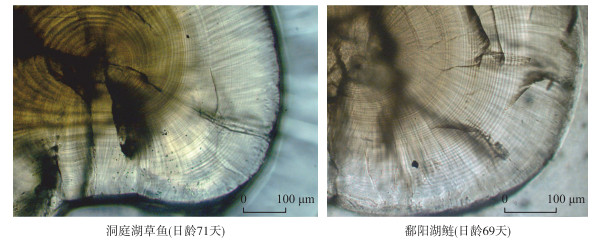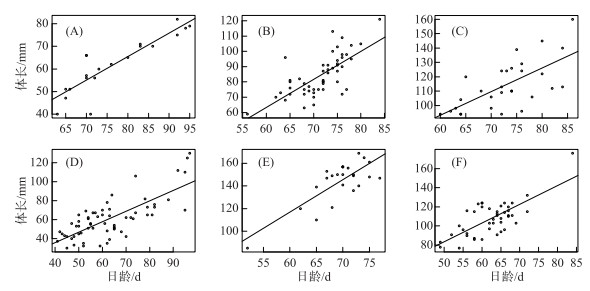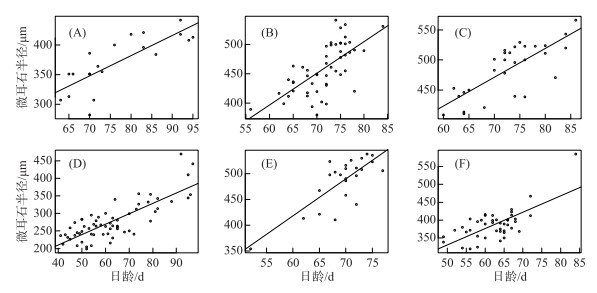(2: 中国科学院大学, 北京 100049)
(3: 南昌师范学院生物系, 南昌 330032)
(2: University of Chinese Academy of Sciences, Beijing 100049, P. R. China)
(3: Department of Biology, Nanchang Normal University, Nanchang 330032, P. R. China)
青鱼(Mylopharyngodon piceus)、草鱼(Ctenopharyngodon idellus)、鲢(Hypophthalmichthys molitrix)和鳙(Aristichthys nobilis)是我国重要的经济鱼类, 合称为四大家鱼, 其养殖产量约占我国淡水养殖产量的约50%[1].
四大家鱼是江湖洄游性鱼类, 产漂流性卵, 产卵活动发生在每年的4月下旬-7月上旬, 成熟亲鱼在繁殖季节从通江湖泊或水库洄游到河流干流产卵.鱼卵随水漂流发育, 幼鱼进入通江湖泊或水库进行生长和发育.四大家鱼产卵需要一定的环境条件[2].黎明政[3]的研究结果显示, 四大家鱼繁殖需要水温达到18℃, 水位日增量大于0.55 m/d.王俊娜等[4]认为家鱼自然繁殖的涨水率为900~3100 m3/(s·d).
三峡水库蓄水后, 三峡水库和长江上游珍稀特有鱼类国家级自然保护区形成了河-库复合生态系统, 为四大家鱼提供了广阔的栖息地, 近年来四大家鱼在三峡水库渔获物中的重量百分比超过20%[5], 说明已经形成了稳定的种群.由于修建堤坝、水闸, 众多长江中下游湖泊与河流形成阻隔, 洞庭湖和鄱阳湖成为长江四大家鱼幼鱼生长发育的主要栖息地.长江上游的河库生态系统与长江中下游通江湖泊的江湖生态系统有相似性也有差异.本研究通过在三峡水库库区、洞庭湖和鄱阳湖采集草鱼和鲢幼鱼, 利用耳石鉴定日龄, 了解长江上游和中游草鱼和鲢的繁殖现状和早期生活史阶段生长特征, 分析不同区域的差异, 探讨相应的保护措施.
1 材料和方法 1.1 样本采集2017年7-8月, 在三峡水库丰都、万州江段及长江中游通江湖泊洞庭湖岳阳水域和鄱阳湖星子水域(图 1)采集草鱼、鲢的幼鱼样本.在丰都和万州采用虾笼, 在岳阳采用地笼、虾笼和高网, 在星子采用迷魂阵.因为幼鱼栖息主要集中在沿岸带的浅滩, 因此收集的幼鱼主要来自于设置在沿岸带较浅水域的网具.样本逐一测量体长(精确至1 mm)、体重(0.1 g)(表 1).摘取两侧微耳石, 用乙醇清洗后风干保存.

|
图 1 三峡水库库区、洞庭湖及鄱阳湖草鱼、鲢幼鱼采样点分布 Fig.1 Distribution of sampling sites of grass carp (Ctenopharyngodon idellus) and silver carp (Hypophthalmichthys molitrix) juveniles in Three Gorges Reservoir, Lake Dongting and Lake Poyang |
| 表 1 草鱼和鲢幼鱼的采样时间、地点和体长 Tab. 1 Sampling time, location and body length of silver crap and grass crap juveniles |
将耳石凸面朝上, 然后用热熔胶包埋于载玻片上, 凸面朝上[6].用3000#防水砂纸打磨, 待耳石中心核暴露后改用8000#抛光纸抛光, 直至耳石表面无划痕.翻转耳石, 使凹面朝上, 重复上述打磨和抛光过程.待耳石轮纹清晰可见时, 用二甲苯进行清洗, 再用指甲油封片.将封片置于光学显微镜下, 在与之相连的电脑成像系统SPOT Insight CCD下对耳石轮纹进行读数和测量半径, 反复矫正两次.
1.3 数据处理草鱼在孵化后第2天才形成第1个日轮[7].目前, 还没有研究证明鲢第1个日轮的形成时间, 因此, 本研究假设鲢第1年轮形成时间与草鱼相同[8].在本研究中, 耳石轮纹数加1为幼鱼的日龄, 采样时间减去日龄为其孵化日期.用R软件进行回归分析及ANCOVA检验.
2 结果 2.1 孵化日期草鱼和鲢幼鱼的采样情况见表 1.根据微耳石轮纹数(图 2)推算出丰都、万州江段草鱼幼鱼孵化日期为4月24日-5月25日, 其中5月10-31日孵化的个体占总体的75%;鲢幼鱼的孵化日期为4月10日-6月12日, 其中5月10-31日孵化的个体约占总体的55%. 2017年8月8-15日洞庭湖采集的草鱼幼鱼的孵化日期为5月21日-6月26日, 其中6月1-10日孵化的个体占总体的45%;鲢幼鱼的孵化日期为5月25日-6月19日, 分布在6月1-10日孵化的个体占总体的75%. 2017年7月28-30日鄱阳湖采集的草鱼幼鱼的孵化日期为5月4日-5月28日, 分布在5月10-31日孵化的个体占总体的79%;鲢幼鱼的孵化日期为5月9日-6月12日, 其中5月20日-6月10日孵化的个体占总体的90%(图 3).

|
图 2 草鱼和鲢微耳石 Fig.2 Lapillar otoliths of grass carp and silver carp |

|
图 3 2017年7-8月在三峡水库、洞庭湖和鄱阳湖采集的草鱼(A)和鲢(B)幼鱼的孵化日期 Fig.3 Hatch date of grass carp (A) and silver carp (B) juveniles sampled from the Three Gorges Reservoir, Lake Dongting and Lake Poyang during July and August 2017 |
鱼类的体长(BL)与体重(W)满足关系式W=a·BLb, 三峡库区、鄱阳湖和洞庭湖草鱼、鲢的体长与体重关系的相关系数由表 2所示. b值为反映不同发育阶段和生长环境中生长发育的特征参数, 当b值为3时, 为匀速生长, 大于或小于3时为异速生长。三峡库区、洞庭湖和鄱阳湖草鱼、鲢的b值与3没有显著差异(P>0.05), 说明草鱼、鲢均为等速生长, 体内营养物质能正常积累(表 2).三峡库区、洞庭湖、鄱阳湖的草鱼和鲢幼鱼的体长与日龄呈显著的线性关系(图 4).三峡库区、洞庭湖、鄱阳湖草鱼样本的体长增长率分别为1.04、1.84和1.64 mm/d.协方差分析结果显示, 洞庭湖和鄱阳湖草鱼幼鱼的体长增长率均大于三峡水库库区, 洞庭湖与三峡水库库区之间差异显著(P < 0.05), 鄱阳湖与三峡水库库区之间则差异不显著(P>0.05).三峡库区、洞庭湖和鄱阳湖鲢幼鱼的体长增长率分别为1.10、2.87和1.96 mm/d.洞庭湖和鄱阳湖鲢幼鱼的体长增长率均显著大于三峡库区(P < 0.05), 洞庭湖与鄱阳湖之间则差异不显著(P>0.05).

|
图 4 三峡水库、洞庭湖和鄱阳湖草鱼和鲢幼鱼的体长与日龄的关系(A:三峡水库草鱼; B:洞庭湖草鱼; C:鄱阳湖草鱼; D:三峡水库鲢; E:洞庭湖鲢; F:鄱阳湖鲢) Fig.4 The correlation between body length and daily age of grass carp and silver carp juveniles collected in Three Gorges Reservoir (TGR), Lake Dongting and Lake Poyang (A:grass carp in TGR; B:grass carp in Lake Dongting; C:grass carp in Lake Poyang; D:silver carp in TGR; E:silver carp in Lake Dongting; F:silver carp in Lake Poyang) |
| 表 2 草鱼和鲢幼鱼体长与体重的关系 Tab. 2 Relationship of body length and weight of grass carp and silver carp juveniles |
回归分析结果显示, 三峡库区、洞庭湖和鄱阳湖的草鱼和鲢幼鱼微耳石半径与日龄呈显著线性关系(图 5).三峡水库库区、洞庭湖和鄱阳湖的草鱼幼鱼微耳石的沉积率分别为3.41、5.41和4.77 μm/d.与三峡水库库区草鱼幼鱼的微耳石沉积率相比, 洞庭湖草鱼幼鱼的微耳石沉积率显著大于三峡水库库区(P < 0.05), 但是鄱阳湖与三峡水库库区相比没有显著差异(P>0.05).三峡水库库区、洞庭湖和鄱阳湖鲢幼鱼的耳石沉积率分别为2.96、7.17和4.57 μm/d.洞庭湖和鄱阳湖鲢幼鱼的微耳石沉积率均显著大于三峡库区鲢(P < 0.05).而洞庭湖与鄱阳湖之间没有显著差异(P>0.05).

|
图 5 三峡水库、洞庭湖和鄱阳湖草鱼和鲢的微耳石半径与日龄的关系(A:三峡水库草鱼; B:洞庭湖草鱼; C:鄱阳湖草鱼; D:三峡水库鲢; E:洞庭湖鲢; F:鄱阳湖鲢) Fig.5 The correlation between otolith radius and daily age of grass carp and silver carp juveniles collected in Three Gorges Reservoir (TGR), Lake Dongting and Lake Poyang (A:grass carp in TGR; B:grass carp in Lake Dongting; C:grass carp in Lake Poyang; D:silver carp in TGR; E:silver carp in Lake Dongting; F:silver carp in Lake Poyang) |
结果显示, 三峡水库蓄水之后, 三峡大坝以上江段仍有四大家鱼繁殖, 繁殖时间与蓄水前相比没有明显差异[9-11].但是, 三峡水库蓄水对长江中游干流江段草鱼和鲢的繁殖时间有明显的影响. 1960s和1980s, 四大家鱼卵苗出现在长江中下游的时间为4-5月[2, 12].三峡水库蓄水后, 长江中游江段和洞庭湖四大家鱼的首次繁殖日期推迟到5月中旬[13].本研究结果显示, 洞庭湖的草鱼和鲢幼鱼孵化时间为5月下旬, 鄱阳湖为5月上旬.在洞庭湖调查到的草鱼和鲢幼鱼的孵化时间与以往的结果相比有所推迟, 而鄱阳湖没有明显变化.洞庭湖的草鱼和鲢幼鱼主要来源于长江干流岳阳以上江段, 栖息于东洞庭湖, 而南洞庭湖较少[14].造成长江中游干流四大家鱼繁殖时间推迟的主要原因为:三峡水库蓄水之后, 春季长江中游水温升高明显滞后, 水温到达18℃的时间平均推迟了19天, 导致长江中游江段四大家鱼产卵时间平均推迟了25天[15].鄱阳湖的四大家鱼幼鱼来源长江干流和赣江等支流.赣江四大家鱼繁殖时间从4月开始[16].在三峡大坝上游繁殖的四大家鱼仔鱼可以通过三峡大坝到达长江中游[17].这些仔鱼有可能顺水漂流长成至有主动游泳能力的时候就可以进入鄱阳湖.因此, 在鄱阳湖调查到的孵化时间在5月初的四大家鱼可能是来源于三峡大坝以上江段或者赣江等支流.
3.2 幼鱼生长速度的差异结果显示, 洞庭湖和鄱阳湖草鱼和鲢幼鱼的体长增长率和耳石沉积率均大于三峡水库.耳石生长与鱼体生长呈显著线性和指数相关[18-19], 在环境条件优越时, 鱼体和耳石生长速度会加快[19].饵料和温度是影响鱼类生长的重要因素[20-21].草鱼幼鱼以摇蚊幼虫、桡足类和无节幼体、藻类等为主要食物[22].鲢幼鱼的食物主要包括浮游动物、浮游植物、藻类、腐屑物[23].三峡水库浮游动物密度与大坝的距离呈负相关, 春、夏季万州、涪陵等江段桡足类密度小于2 ind./L[24].洞庭湖浮游动物的密度为3400~5000 ind./L[25], 鄱阳湖子湖浮游动物的密度为10551~73173 ind./L[26], 明显高于三峡水库.因此, 洞庭湖和鄱阳湖草鱼和鲢幼鱼的饵料更加丰富, 更有利于幼鱼生长发育.
本研究结果显示, 洞庭湖草鱼幼鱼的体长增长率(1.84 mm/d)小于管兴华等[6]的研究结果(3.54 mm/d); 鄱阳湖草鱼幼鱼的体长增长率(1.64 mm/d)与李建军等(1.43 mm/d)和朱其广(1.70 mm/d)的研究结果相差不大, 而鄱阳湖鲢幼鱼的体长增长率(1.96 mm/d)介于李建军等(0.93 mm/d)和朱其广(2.54 mm/d)的研究结果之间[27-28].造成生长速度差异的主要原因有水温、饵料生物丰度、栖息地和捕捞[29-32].
3.3 保护措施建议洞庭湖和鄱阳湖的过度捕捞现象还是十分严重[33].禁渔期之后, 迷魂阵等非法的渔具渔法没有得到有效的控制, 对幼鱼资源造成了巨大的破坏.在鄱阳湖, 渔船的日均单船捕捞量可以达到数吨(中国科学院水生生物研究所未发表数据).在长江中游放流了四大家鱼亲鱼之后[34], 宜昌江段的四大家鱼产卵规模明显增加(中国科学院水生生物研究所未发表数据).这表明长江中游鱼类产卵规模小主要是因为繁殖亲鱼数量少.过度捕捞是造成鱼类种群的补充群体数量急剧减少的最主要原因之一.为了消除过度捕捞的影响, 恢复长江鱼类资源, 长江全面禁渔已经逐步实施, 2020年1月1日起保护区将实施禁捕, 2021年长江将全面禁渔.
从2011年开始, 三峡水库开始开展试验性生态调度, 促进三峡大坝下游四大家鱼的自然繁殖活动.高勇[35]报道生态调度期间长江中游鱼卵径流量超过了总量的50%.周雪等[36]的调查结果显示, 2013-2017年生态调度在6月下旬持续涨水4天及以上, 流量增长1600~2833 m3/(s·d), 会促使四大家鱼集中繁殖.已有研究结果显示, 生态调度能够提供鱼类繁殖所需要的水文条件, 有利于鱼类的繁殖活动.俞立雄[37]认为当流量为15000~21300 m3/s时, 长江中游宜都和枝城四大家鱼产卵场的适宜度面积较高, 推荐作为三峡水库生态调度的目标流量.但是, 因为是生态调度试验, 因此2013-2017年每年仅开展1~3次调度, 平均每次7.3天, 每年14.6天, 时间较短, 能够产生的效果也是有限的.而且, 目前的调度仅考虑到长江中下游的流量变化.三峡水库库区及上游江段也有包括四大家鱼在内的鱼类产卵场[38-39], 三峡水库调度造成的水位波动也会影响库区的产卵场.同时, 金沙江梯级开发将进一步影响长江的水文情势, 长江上游及中游的鱼类繁殖也将受到进一步的影响.因此, 建议制定三峡水库及上游水库群的联合调度方案, 开展联合调度, 满足长江鱼类繁殖所需的水文条件.
长江中下游的湖泊曾是幼鱼生长和发育的主要栖息地.然而, 现在长江中下游的通江湖泊所剩无几.江湖阻隔造成了鱼类栖息地减少, 鱼类多样性急剧减少[40-41]. 2005年起, 在湖北省的涨渡湖开展了江湖连通恢复工程, 结果显示, 江湖连通后鱼类种类增加, 渔业产量增加[42].因此, 建议保护和修复鱼类栖息地, 同时减少江湖阻隔, 开展灌江纳苗, 增加幼鱼的栖息地.
总体而言, 为了保护和恢复长江鱼类资源, 除了全面禁渔之外, 还建议开展三峡水库以及上游水库的联合调度, 满足长江鱼类的繁殖环境条件; 保护和修复鱼类栖息地; 减少江湖阻隔; 加大力度增殖放流珍稀特有鱼类及重要经济鱼类的亲鱼.
致谢:感谢刘焕章研究员对本论文的指导和修改, 但胜国、翟东东、李文静对样本的采集, 王健对鉴定耳石日轮提供的帮助.
| [1] |
Fisheries Administrative of the Ministry of Agriculture and Rural areas, National Aquatic Technology Popularization General Station, China Society of Fisheries eds. China fishery statistical yearbook: first edition. Beijing: China Agricultural Press, 2018. [农业农村版部渔业渔政管理局, 全国水产技术推广总站, 中国水产学会. 2018中国渔业统计年鉴: 第1版.北京: 中国农业出版社, 2018. ]
|
| [2] |
Yi BL, Yu ZT, Liang ZS et al. Gezhouba water control project and four famous fishes in Yangtze River: First edition. Wuhan: Hubei Science Technology Press, 1988: 1-46. [易伯鲁, 余志堂, 梁秩燊等.葛洲坝水利枢纽与长江四大家鱼: 第1版.武汉: 湖北科学技术出版社, 1988: 1-46. ]
|
| [3] |
Li MZ. Study on the life history strategies of fishes in the Yangtze River and its adaption to environment during early life history stage[Dissertation]. Wuhan: Institute of Hydrobiology, Chinese Academy of Sciences, 2012. [黎明政.长江鱼类生活史对策及其早期生活史阶段对环境的适应[学位论文].武汉: 中国科学院水生生物研究所, 2012. ]
|
| [4] |
Wang JN, Li C, Liao WG. Impacts of the regulation of Three Gorges-Gezhouba cascaded reservoirs on downstream eco-hydrology. Journal of Hydroelectric Engineering, 2011, 30(2): 84-90, 95. [王俊娜, 李翀, 廖文根. 三峡-葛洲坝梯级水库调度对坝下河流的生态水文影响. 水力发电学报, 2011, 30(2): 84-90, 95.] |
| [5] |
Yang Z, Gong Y, Dong C et al. Temporal and spatial distribution of the four major Chinese carp species in Three Gorges Reservoir during the normal operating period. Journal of Hydroecology, 2017, 38(5): 72-79. [杨志, 龚云, 董纯等. 三峡水库正常运行期间四大家鱼的时空分布特征. 水生态学杂志, 2017, 38(5): 72-79. DOI:10.15928/j.1674-3075.2017.05.010] |
| [6] |
Guan XH, Cao WX. Study on the hatch date and growth of juvenile grass carp from middle reaches of the Yangtze River using daily increment technology. Acta Hydrobiologica Sinica, 2007, 31(1): 18-23. [管兴华, 曹文宣. 利用耳石日轮技术研究长江中游草鱼幼鱼的孵化期及生长. 水生生物学报, 2007, 31(1): 18-23.] |
| [7] |
Zeng XB, Zhang GH. Species identification at the larval and juvenile stages for several Chinese domestic fishes by elliptical Fourier analysis of otolith form. Journal of Fishery Sciences of China, 2012, 19(6): 970-977. [曾祥波, 张国华. 基于傅立叶耳石形态分析法对几种家鱼仔稚鱼的种类判别分析. 中国水产科学, 2012, 19(6): 970-977. DOI:10.3724/SP.J.1118.2012.00970] |
| [8] |
Chang JB, Deng ZL, Sun JY et al. Daily increments of otoliths in larvae and juveniles of grass carp, Ctenopharygodon idellus. Sixtieth Anniversary of the Founding of China Zoological Society Memorial Volume Dedicated to the Hundredth Anniversary of the Birthday of the Late Prof.Sisan CHEN. Beijing: Chinese Technology Press, 1994: 323-329. [常剑波, 邓中粦, 孙建贻等.草鱼仔幼鱼耳石日轮及日龄研究//中国动物学会成立60周年: 纪念陈桢教授诞辰100周年论文集.北京: 中国科学技术出版社, 1994: 323-329. ]
|
| [9] |
Wang HL, Li MZ, Gao X et al. The status of the early stage fish resources in the Fengdu section of the Three Gorges reservoir. Acta Hydrobiologica Sinica, 2015, 39(5): 954-964. [王红丽, 黎明政, 高欣等. 三峡库区丰都江段鱼类早期资源现状. 水生生物学报, 2015, 39(5): 954-964. DOI:10.7541/2015.125] |
| [10] |
Jiang W. Studies on fish early resources in the main stream of state-level natural protection area for rare and endemic fishes in the upper Yangtze River[Dissertation]. Wuhan: Institute of Hydrobiology, Chinese Academy of Sciences, 2009. [姜伟.长江上游珍稀特有鱼类国家级自然保护区干流江段鱼类早期资源研究[学位论文].武汉: 中国科学院水生生物研究所, 2009. ]
|
| [11] |
Survey team of spawing grounds of domestic fishes in Changjiang river. A survey on the spawing grounds of the "four famous Chinese carps"in the Changjiang River after dammed by the key water control project at Gezhouba. Journal of Fisheries of China, 1982, 6(4): 287-305. [长江四大家鱼产卵场调查队.葛洲坝水利枢纽工程截流后长江四大家鱼产卵场调查.水产学报, 1982, 6(4): 287-305. ]
|
| [12] |
Liu LH, Wu GX, Chao WX et al. Studies on the ecological effect on spawning of the black carp, the grass carp, the silver carp and the bighead carp in the Changjiang River after the constructions of the Gezhouba hydroelectric project. Acta Hydrobiologica Sinica, 1986, 10(4): 353-364. [刘乐和, 吴国犀, 曹维孝等. 葛洲坝水利枢纽兴建后对青、草、鲢、鳙繁殖生态效应的研究. 水生生物学报, 1986, 10(4): 353-364.] |
| [13] |
Zhang G, Wu L, Duan M et al. Hatch dates and early growth for juveniles of the four major carps from different sections of the middle Yangtze River. Acta Hydrobiologica Sinica, 2013, 37(2): 306-313. [张国, 吴朗, 段明等. 长江中游不同江段四大家鱼幼鱼孵化日期和早期生长的比较研究. 水生生物学报, 2013, 37(2): 306-313. DOI:10.7541/2013.19] |
| [14] |
Ru HJ, Liu XQ, Huang XR et al. Diversity of fish species and its spatio-temporal variations in Lake Dongting, a large Yangtze-connected lake. J Lake Sci, 2008, 20(1): 93-99. [茹辉军, 刘学勤, 黄向荣等. 大型通江湖泊洞庭湖的鱼类物种多样性及其时空变化. 湖泊科学, 2008, 20(1): 93-99. DOI:10.18307/2008.0114] |
| [15] |
Li MZ, Duan ZH, Gao X et al. Impact of the Three Gorges Dam on reproduction of four major Chinese carps species in the middle reaches of the Changjiang River. Chinese Journal of Oceanology and Limnology, 2016, 34(5): 885-893. DOI:10.1007/s00343-016-4303-4302 |
| [16] |
Liu BB, Wu ZQ, Hu ML et al. Spawning sites of four major Chinese carps in the middle reaches of Ganjiang River. Jiangxi Science, 2009, 27(5): 662-666, 679. [刘彬彬, 吴志强, 胡茂林等. 赣江中游四大家鱼产卵场现状初步调查. 江西科学, 2009, 27(5): 662-666, 679.] |
| [17] |
Mu HX, Li MZ, Liu HZ et al. Analysis of fish eggs and larvae flowing into the Three Gorges reservoir on the Yangtze River, China. Fisheries Science, 2014, 80(3): 505-515. DOI:10.1007/s12562-014-0729-7 |
| [18] |
Campana SE, Neilson JD. Microstructure of fish otoliths. Canadian Journal of Fisheries and Aquatic Sciences, 1985, 42(5): 1014-1032. DOI:10.1139/f85-127 |
| [19] |
Campana SE, Thorrold SR. Otoliths, increments, and elements:keys to a comprehensive understanding of fish populations?. Canadian Journal of Fisheries and Aquatic Sciences, 2001, 58(1): 30-38. DOI:10.1139/cjfas-58-1-30 |
| [20] |
Takahashi M, Watanabe Y. Effects of temperature and food availability on growth rate during late larval stage of Japanese anchovy (Engraulis japonicus) in the Kuroshio-Oyashio transition region. Fisheries Oceanography, 2005, 14(3): 223-235. DOI:10.1111/j.1365-2419.2005.00334.x |
| [21] |
Mann RHK. Temporal and spatial variations in the growth of 0 group roach (Rutilus rutilus) in the River Great Ouse, in relation to water temperature and food availability. Regulated Rivers:Research & Management, 1997, 13(3): 277-285. |
| [22] |
Li CC. Study on the diet of grass carp. Chinese Science Bulletin, 1981, 26(5): 311-312. [李长春. 草鱼食性问题的研究. 科学通报, 1981, 26(5): 311-312.] |
| [23] |
He ZH, Li YH. Discussion on the food of sliver (Hypophthalmichthys molitrix). Acta Hydrobiologica Sinica, 1975(4): 541-548. [何志辉, 李永函. 论白鲢的食物问题. 水生生物学集刊, 1975(4): 541-548.] |
| [24] |
Yao JL, Xue JZ, Wang DY et al. Seasonal variation and longitudinal distribution of copepods in the main river area of the Three Gorges Reservoir. Biodiversity Science, 2007, 15(3): 300-305. [姚建良, 薛俊增, 王登元等. 三峡水库初次蓄水后干流库区桡足类的纵向分布与季节变化. 生物多样性, 2007, 15(3): 300-305.] |
| [25] |
Wang MQ, Wang JC, Wang Q et al. Characteristics of plankton community structure and eutrophication status in Dongting Lake in the season with normal water level. Chinese Journal of Ecology, 2018, 37(8): 2418-2429. [汪梦琪, 汪金成, 王琪等. 洞庭湖区平水期浮游生物群落结构特征及富营养化现状. 生态学杂志, 2018, 37(8): 2418-2429. DOI:10.13292/j.1000-4890.201808.004] |
| [26] |
Zhang T, Ma XH, Wang GP et al. Community structure and spatial distribution of plankton in the Poyang lake national nature reserve, China. Acta Hydrobiologica Sinica, 2014, 38(1): 158-165. [张婷, 马行厚, 王桂苹等. 鄱阳湖国家级自然保护区浮游生物群落结构及空间分布. 水生生物学报, 2014, 38(1): 158-165. DOI:10.7541/2014.21] |
| [27] |
Li JJ, Wu ZQ, Hu ML. Study onotolith and growth in juvenile of the four domestic fishes from Hukou section of the Yangtze River. Journal of Hydroecology, 2010, 31(6): 56-61. [李建军, 吴志强, 胡茂林. 长江湖口水域四大家鱼幼鱼的耳石与生长研究. 水生态学杂志, 2010, 31(6): 56-61. DOI:10.15928/j.1674-3075.2010.06.013] |
| [28] |
Zhu QG. Study on variation of fish community structure in Poyang lake channel in summer and autumn and theotolith and growth of juvenile domestic Chinese carps[Dissertation]. Nanchang: Nanchang University, 2011. [朱其广.鄱阳湖通江水道鱼类夏秋季群落结构变化和四大家鱼幼鱼耳石与生长的研究[学位论文].南昌: 南昌大学, 2011. ]
|
| [29] |
Jones GP. Food availability affects growth in a coral reef fish. Oecologia, 1986, 70(1): 136-139. DOI:10.1007/bf00377123 |
| [30] |
Enberg K, Jørgensen C, Dunlop ES et al. Fishing-induced evolution of growth:Cncepts, mechanisms and the empirical evidence. Marine Ecology, 2012, 33(1): 1-25. DOI:10.1111/j.1439-0485.2011.00460.x |
| [31] |
Tupper M, Boutilier RG. Effects of habitat on settlement, growth, and postsettlement survival of Atlantic cod (Gadus morhua). Canadian Journal of Fisheries and Aquatic Sciences, 1995, 52(9): 1834-1841. DOI:10.1139/f95-176 |
| [32] |
Li H, Shen JZ, Ma XF et al. Growth characteristics of roach Rutilus rutilus (L.) in Ulungur Lake in Xinjiang Uigur Autonomous Region. Journal of Huazhong Agricultural University, 2009, 28(2): 202-206. [李鸿, 沈建忠, 马徐发等. 新疆乌伦古湖湖拟鲤的生长特征. 华中农业大学学报, 2009, 28(2): 202-206.] |
| [33] |
Liao FC, He W, Huang XR et al. Studies on present situation and change trend of Dongting Lake fishery resources and environment. Acta Hydrobiologica Sinica, 2002, 26(6): 623-627. [廖伏初, 何望, 黄向荣等. 洞庭湖渔业资源现状及其变化. 水生生物学报, 2002, 26(6): 623-627.] |
| [34] |
Sun MS, Wang K, Duan XB et al. Distribution characteristics of non-bottom fishes in the middle reaches of the Yangtze River from Chenglingji to Yichang section. Freshwater Fisheries, 2013, 43(4): 45-50. [孙铭帅, 王珂, 段辛斌等. 长江中游城陵矶至宜昌江段非底部鱼类分布特征研究. 淡水渔业, 2013, 43(4): 45-50.] |
| [35] |
Gao Y. Ecological dispatching of the Three Gorges Project. China Three Gorges, 2017(12): 88-91. [高勇. 三峡工程的生态调度. 中国三峡, 2017(12): 88-91.] |
| [36] |
Zhou X, Wang K, Chen DQ et al. Effects of ecological operation of Three Gorges Reservoir on larval resources of the four major Chinese carps in Jianli section of the Yangtze River. Journal of fisheries of China, 2019, 43(8): 1781-1789. [周雪, 王珂, 陈大庆等. 三峡水库生态调度对长江监利江段四大家鱼早期资源的影响. 水产学报, 2019, 43(8): 1781-1789.] |
| [37] |
Yu LX. Study on the topography and hydrodynamic characteristics of the four major Chinese carps' typical spawning grounds in the middle reaches of the Yangtze River[Dissertation]. Chongqing: Southwest University, 2018. [俞立雄.长江中游四大家鱼典型产卵场地形及水动力特征研究[学位论文].重庆: 西南大学, 2018. ]
|
| [38] |
Jiang W, Liu HZ, Duan ZH et al. Seasonal variation in drifting eggs and larvae in the upper Yangtze. China Zool Sci, 2010, 27(5): 402-409. |
| [39] |
Mu HX. Study on fish early resources at the end of Three Gorges Resevoir and below the Three Gorges Dam[Dissertation]. Wuhan: Institute of Hydrobiology, Chinese Academy of Sciences, 2014. [母红霞.长江三峡水库库尾江段及三峡坝下鱼类早期资源生态学研究[学位论文].武汉: 中国科学院水生生物研究所, 2014. ]
|
| [40] |
Liu XQ, Wang HZ. Estimation of minimum area requirement of river-connected lakes for fish diversity conservation in the Yangtze River floodplain. Diversity and Distributions, 2010, 16: 932-940. |
| [41] |
Liu XQ, Wang HZ. Effects of loss of lateral hydrological connectivity on fish functional diversity. Conservation Biology, 2018, 32(6): 1336-1345. DOI:10.1111/cobi.13142 |
| [42] |
Wu B, Zhao Q, Ma FK. Study on restoration of the relationship between blocking lakes and Yangtze River. Environmental Science Survey, 2019, 38(5): 10-14. [吴波, 赵强, 马方凯. 长江中下游江湖关系恢复研究. 环境科学导刊, 2019, 38(5): 10-14.] |
 2020, Vol. 32
2020, Vol. 32 

